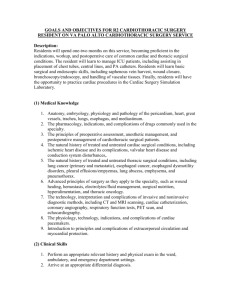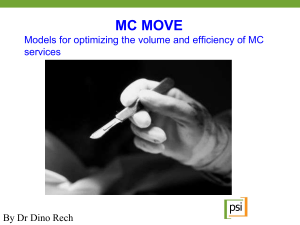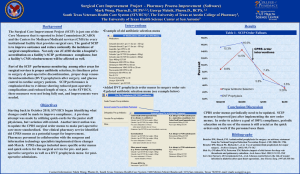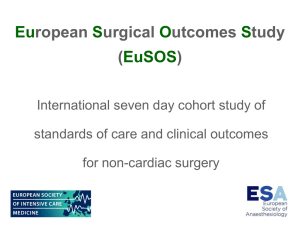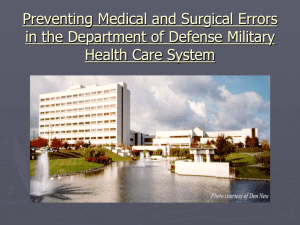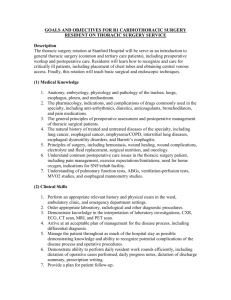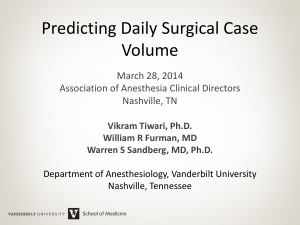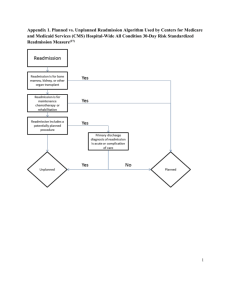A Business Case for SCIP - Tennessee Center for Patient Safety
advertisement
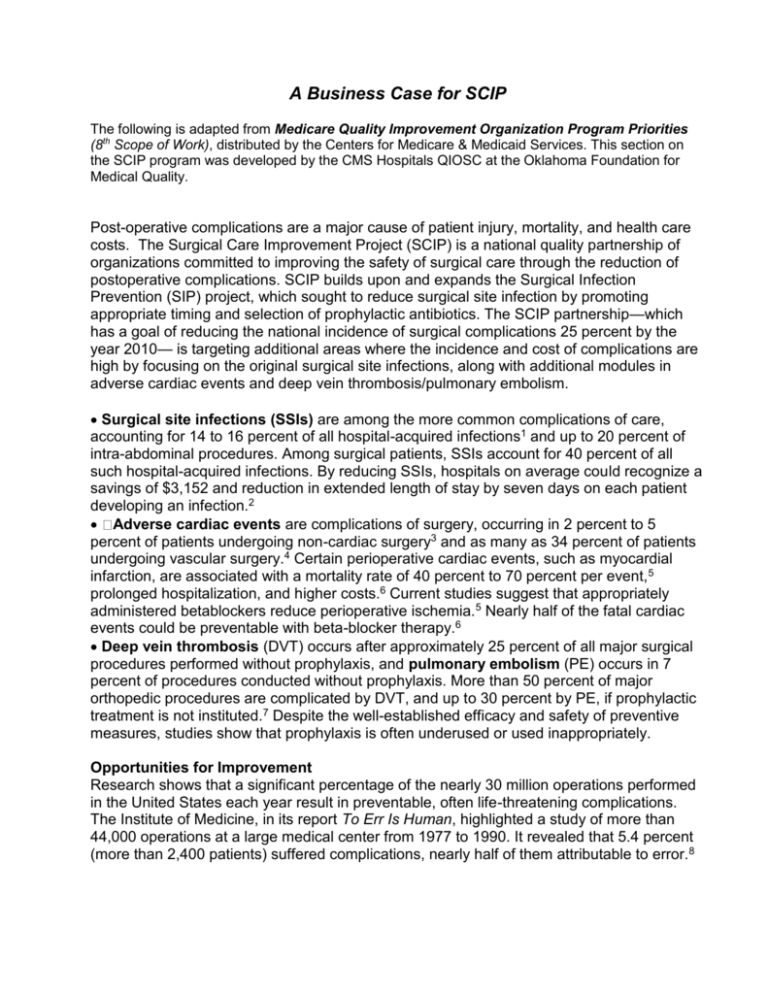
A Business Case for SCIP The following is adapted from Medicare Quality Improvement Organization Program Priorities (8th Scope of Work), distributed by the Centers for Medicare & Medicaid Services. This section on the SCIP program was developed by the CMS Hospitals QIOSC at the Oklahoma Foundation for Medical Quality. Post-operative complications are a major cause of patient injury, mortality, and health care costs. The Surgical Care Improvement Project (SCIP) is a national quality partnership of organizations committed to improving the safety of surgical care through the reduction of postoperative complications. SCIP builds upon and expands the Surgical Infection Prevention (SIP) project, which sought to reduce surgical site infection by promoting appropriate timing and selection of prophylactic antibiotics. The SCIP partnership—which has a goal of reducing the national incidence of surgical complications 25 percent by the year 2010— is targeting additional areas where the incidence and cost of complications are high by focusing on the original surgical site infections, along with additional modules in adverse cardiac events and deep vein thrombosis/pulmonary embolism. Surgical site infections (SSIs) are among the more common complications of care, accounting for 14 to 16 percent of all hospital-acquired infections1 and up to 20 percent of intra-abdominal procedures. Among surgical patients, SSIs account for 40 percent of all such hospital-acquired infections. By reducing SSIs, hospitals on average could recognize a savings of $3,152 and reduction in extended length of stay by seven days on each patient developing an infection.2 Adverse cardiac events are complications of surgery, occurring in 2 percent to 5 percent of patients undergoing non-cardiac surgery3 and as many as 34 percent of patients undergoing vascular surgery.4 Certain perioperative cardiac events, such as myocardial infarction, are associated with a mortality rate of 40 percent to 70 percent per event, 5 prolonged hospitalization, and higher costs.6 Current studies suggest that appropriately administered betablockers reduce perioperative ischemia.5 Nearly half of the fatal cardiac events could be preventable with beta-blocker therapy.6 Deep vein thrombosis (DVT) occurs after approximately 25 percent of all major surgical procedures performed without prophylaxis, and pulmonary embolism (PE) occurs in 7 percent of procedures conducted without prophylaxis. More than 50 percent of major orthopedic procedures are complicated by DVT, and up to 30 percent by PE, if prophylactic treatment is not instituted.7 Despite the well-established efficacy and safety of preventive measures, studies show that prophylaxis is often underused or used inappropriately. Opportunities for Improvement Research shows that a significant percentage of the nearly 30 million operations performed in the United States each year result in preventable, often life-threatening complications. The Institute of Medicine, in its report To Err Is Human, highlighted a study of more than 44,000 operations at a large medical center from 1977 to 1990. It revealed that 5.4 percent (more than 2,400 patients) suffered complications, nearly half of them attributable to error. 8 A 2003 study found that postoperative complications accounted for up to 22 percent of preventable deaths among patients, depending on the complication. The same study looked at 18 types of medical injuries during hospitalization and found those events accounted for 2.4 million additional hospital days and $9.3 billion in additional charges.9 Although some surgical complications are unavoidable, surgical care can be improved through better adherence to evidence-based practice recommendations and by giving more attention to designing systems of care with redundant safeguards. Research shows, for example, that delivering antibiotics to a patient within one hour of beginning surgery can dramatically cut SSI rates, yet this practice is far from universal. In other examples, application of the National Surgical Quality Improvement Program (NSQIP) within the Department of Veterans Affairs resulted in a 27 percent reduction in mortality related to surgery.10 Hospitals participating in the National Nosocomial Infections Surveillance (NNIS) system of the CDC have shown reductions of up to 44 percent in device-associated and SSI rates.11 The national network of Medicare QIOs, working under contract to CMS, recently conducted a surgical infection prevention collaborative that effectively reduced SSIs by 27 percent at 56 centers across the country. References 1. Delgado-Rodriguez M, Sillero-Arenas M, Medina-Cuadros M, Martinez-Gallego G. Nosocomial infections in surgical patients: Comparison of two measures of intrinsic patient risk. Infect Control Hosp Epidemiol 1997;18:19–23. 2. Polk HC, Christmas AB. Prophylactic antibiotics in surgery and surgical wound infections. Am Surg 2000;66:105–111. 3. Auerbach AD, Goldman L. β-blockers and reduction of cardiac events in noncardiac surgery. JAMA 2002; 287:1435–1443. 4. Poldermans D, Boersma E, Bax JJ, et al. The effect of bisoprolol on perioperative mortality and myocardial infarction in high-risk patients undergoing vascular surgery. N Engl J Med 1999;341:1789–1794. 5. Eagle KA, Brundage BH, Chaitman BR, et al. Guidelines for perioperative cardiovascular evaluation for noncardiac surgery: An abridged version of the report of the ACA/AHA Task Force on Practice Guidelines. Mayo Clin Proc 1997;72:524–531. 6. Lindenauer PK, Fitzgerald MS, Hoople N, et al. The potential preventability of postoperative myocardial infection. Arch Intern Med 2004;164:762–766. 7. Geerts WH, Heit, JA, Clagett GP, et al. Prevention of venous thomboembolism. Chest 2001; 119:132S–175S. 8. Kohn LT, Corrigan JM, Donaldson M, et al. To Err is Human: Building a Safer Health System. Washington DC. Institute of Medicine; 2000. 9. Zhan C, Miller MR. Excess length of stay, charges and mortality attributable to medical injuries during hospitalization. JAMA 2003;290:1868–1874. 10. Khuri SF, Daley J, Henderson WG. The comparative assessment and improvement of quality of surgical care in the Department of Veterans Affairs. Arch Surg 2002;137(1): 20–7. 11. Centers for Disease Control and Prevention. Monitoring hospital-acquired infections to promote patient safety—United States 1990–1999. MMWR 2000;49(8):149–172.



